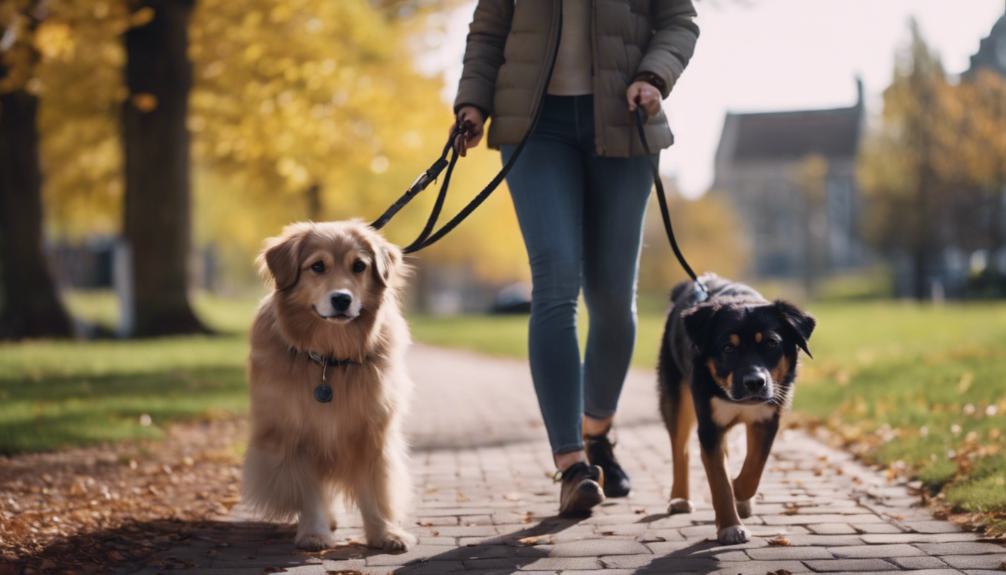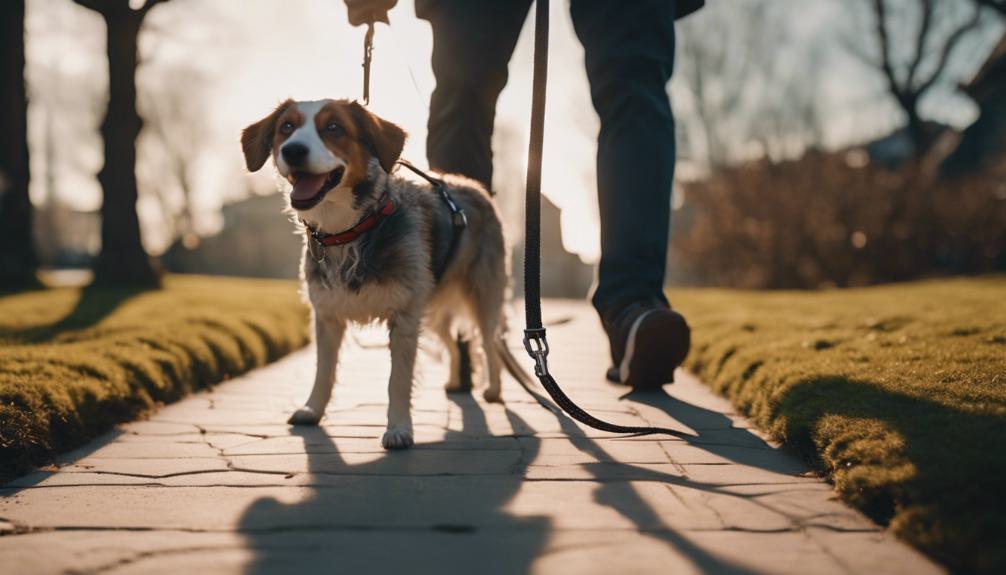How to Train Your Dog Heel? Mastering Leash Manners
To train your dog to heel, start with high-value treats and a safe training area. Position your dog on your left side, treats at chest level, and guide with your hand. Use commands like ‘Look’ and reward consistently. Leash control is crucial; opt for a standard leash and be firm but gentle. Reward-based methods work best, shifting from food to verbal praise. Bring in distractions slowly, offering rewards for refocusing. Gradually reduce treats to maintain good behavior. Troubleshoot common issues with consistency and seek professional help if needed. For advanced training, practice in different environments with stops and sits. Mastering these will bring you closer to heel perfection.
Training Preparation
Prepare for training by collecting high-value treats that your dog loves.
Make sure the training area is safe for off-leash activities. It’s crucial to use the right incentives.
Choose treats that your dog finds irresistible to keep them focused and eager to learn.
Use small pieces of treats to avoid overfeeding. For smaller or more challenging dogs, a long-handled spoon with peanut butter can be effective.
Proper Heeling Position
Position your dog on your left side to teach them how to heel correctly. This setup improves your ability to communicate and control your pet during walks. Keep treats at chest level to prevent your dog from jumping.
Use the hand nearest to your dog to guide them into the correct position. Introduce commands like ‘Look’ or ‘Watch Me‘ to keep their attention on you. Reward your dog consistently with a click or a verbal cue when they heel properly.
This approach helps build a solid foundation for leash walking and obedience training.
Leash Control Techniques

To improve your dog’s heeling skills, it’s crucial to use effective leash control techniques during training. Here are some practical tips to consider:
- Opt for a standard leash, ideally between 4 to 6 feet long, to maintain the right distance and control.
- Steer clear of retractable leashes, as they hinder consistent positioning and communication.
- Maintain a firm, yet gentle grip on the leash to guide your dog properly.
- Apply leash cues and corrections consistently, ensuring clear communication.
- Regularly practice using the leash to reinforce the desired heeling behavior.
These strategies will help you train your dog more efficiently, focusing on clear and direct commands.
Reward-Based Training Methods
To improve your dog’s heeling skills, use reward-based training methods such as treats, verbal praise, and physical rewards. Treats are crucial for effective training. Your dog requires immediate, frequent, and consistent rewards to learn and repeat the desired behavior. To prevent your dog from lunging and to maintain the correct heeling position, teach them to take treats next to your leg. Gradually transition from food rewards to verbal and physical reinforcements to establish long-term heeling habits. Below is a table summarizing the benefits of reward-based training methods:
| Reward-Based Training Methods | Benefits |
|---|---|
| Treats | Enhance focus |
| Verbal Praise | Support good behavior |
| Physical Rewards | Develop long-term habits |
This approach ensures clarity and practicality, promoting a straightforward understanding of how to train your dog effectively using rewards.
Distraction Training Strategies

Introduce distractions slowly during your dog’s training sessions to boost their focus and ability to respond. Distraction training is crucial for helping your dog stay well-behaved, even when there are lots of things going on around them. Below are some practical strategies to effectively train your dog in the presence of distractions:
Begin training in a low-distraction setting. This creates a controlled environment where your dog can learn without too much interference.
Increase the level of distractions gradually. You might introduce sounds, other animals, or moving objects slowly to not overwhelm your dog.
Offer high-value treats to keep your dog focused. These treats will help your dog pay attention to you even when there are distractions.
Practice getting your dog to heel again if they become distracted. This helps them learn to refocus on you.
Always reward the behavior you want to see. This reinforcement helps your dog learn to handle distractions better over time.
Transitioning to Treat-Free Training
Transition to treat-free training by gradually reducing your use of treats while still keeping your dog’s behavior on track. Use treats less frequently to strengthen heeling, without depending solely on food rewards.
Increase the time between treats to slowly lessen your dog’s reliance on them. During training sessions, decrease how often you give treats to help your dog maintain focus and self-control.
Consistently reinforce heeling commands to make sure you successfully move to treat-free training. By slowly cutting back on treats and focusing on consistent commands, you can maintain your dog’s good behavior without constant food rewards, making your training efforts more dependable and long-lasting.
Troubleshooting Common Issues

To identify the root cause of your dog’s heeling problems, follow these practical steps to improve their behavior:
- Adjust the training environment: Reduce distractions that hinder your dog’s focus during heeling. This could mean choosing a quieter place for practice.
- Consistency in cues and rewards: Always use the same commands and give rewards promptly to reinforce good heeling behavior.
- Gradually increase difficulty: Slowly introduce more challenging heeling exercises to keep your dog engaged and improving.
- Seek professional guidance: If issues continue, getting advice from a professional dog trainer can be beneficial.
- Practice loose leash walking: Start with teaching your dog to walk without pulling on the leash as a foundation for better heeling skills.
These steps are designed to be clear and straightforward, helping you tackle heeling issues effectively without unnecessary complexity.
Advanced Heel Proofing Techniques
To improve your dog’s heeling skills, apply advanced heel proofing techniques that increase control and reliability amidst distractions. Practice heeling for extended periods in different environments to reinforce the behavior despite distractions.
Include stops and sits in your heeling routine to enhance control and focus, emphasizing the importance of clear communication with your dog. Gradually decrease the use of treats while keeping the heeling correct to develop endurance and reliability.
Maintain consistency in training to solidify your dog’s understanding and response to commands. By using these methods in your training approach, you can enhance your dog’s heeling capabilities, resulting in a well-behaved companion in various situations.
Frequently Asked Questions
How Do I Teach My Dog to Heel?
To teach your dog to heel, begin with positive reinforcement and practicing in various environments. Consistency and patience are essential. Reward good behavior with treats and praise. Gradually increase the difficulty for better results.
What Age Should You Teach Your Dog to Heel?
You should start teaching your dog to heel around 6 months of age. Young puppies can learn basic leash manners, and older dogs can be trained with patience. Tailor training to your dog’s age and abilities for success.
Is It Too Late to Teach My Dog to Heel?
It’s never too late to teach your dog to heel. With patience and consistency, dogs of all ages can learn this skill. Start with foundational training and use positive reinforcement. You’ll see progress with tailored methods.
Should a Dog Heel the Entire Walk?
You don’t need your dog to heel the whole walk. Short bouts of heeling training are effective. Gradually increase heeling time. Short, focused sessions with breaks work best. Mix in heeling at different points. Balance with free exploration for a well-rounded walk.
Conclusion
Now that you’ve mastered the basics of teaching your dog to heel, it’s important to remain patient and consistent.
Practice in various settings and gradually introduce more distractions to reinforce your dog’s heeling ability.
Use correct techniques and positive reinforcement to make training effective. By doing so, both you and your dog will benefit from enjoyable and successful walks.
Keep working hard and appreciate the relationship that grows with training.

